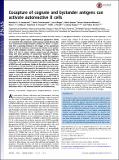| dc.contributor.author | Sanderson, Nicholas S. R. | |
| dc.contributor.author | Zimmermann, Maria | |
| dc.contributor.author | Eilinger, Luca | |
| dc.contributor.author | Gubser, Céline | |
| dc.contributor.author | Schaeren-Wiemers, Nicole | |
| dc.contributor.author | Lindberg, Raija L. P. | |
| dc.contributor.author | Dougan, Stephanie K. | |
| dc.contributor.author | Kappos, Ludwig | |
| dc.contributor.author | Derfuss, Tobias | |
| dc.contributor.author | Ploegh, Hidde | |
| dc.date.accessioned | 2018-05-01T17:17:28Z | |
| dc.date.available | 2018-05-01T17:17:28Z | |
| dc.date.issued | 2017-01 | |
| dc.date.submitted | 2016-09 | |
| dc.identifier.issn | 0027-8424 | |
| dc.identifier.issn | 1091-6490 | |
| dc.identifier.uri | http://hdl.handle.net/1721.1/115131 | |
| dc.description.abstract | Autoantibodies against myelin oligodendrocyte glycoprotein (MOG) are associated with autoimmune central nervous system diseases like acute disseminated encephalomyelitis (ADEM). For ADEM, it is speculated that a preceding infection is the trigger of the autoimmune response, but the mechanism connecting the infection to the production of MOG antibodies remains a mystery. We reasoned that the ability of B cells to capture cognate antigen from cell membranes, along with small quantities of coexpressed “bystander” antigens, might enable B-cell escape from tolerance. We tested this hypothesis using influenza hemagglutinin as a model viral antigen and transgenic, MOG-specific B cells. Using flow cytometry and live and fixed cell microscopy, we show that MOG-specific B cells take up large amounts of MOG from cell membranes. Uptake of the antigen from the membrane leads to a strong activation of the capturing B cell. When influenza hemagglutinin is also present in the membrane of the target cell, it can be cocaptured with MOG by MOG-specific B cells via the B-cell receptor. Hemagglutinin and MOG are both presented to T cells, which in turn are activated and proliferate. As a consequence, MOG-specific B cells get help from hemagglutinin-specific T cells to produce anti-MOG antibodies. In vivo, the transfer of MOG-specific B cells into recipient mice after the cocapture of MOG and hemagglutinin leads to the production of class-switched anti-MOG antibodies, dependent on the presence of hemagglutinin-specific T cells. This mechanism offers a link between infection and autoimmunity. Keywords: tolerance; autoantibodies; antigen capture; antigen presentation; influenza | en_US |
| dc.publisher | National Academy of Sciences (U.S.) | en_US |
| dc.relation.isversionof | http://dx.doi.org/10.1073/PNAS.1614472114 | en_US |
| dc.rights | Article is made available in accordance with the publisher's policy and may be subject to US copyright law. Please refer to the publisher's site for terms of use. | en_US |
| dc.source | National Academy of Sciences | en_US |
| dc.title | Cocapture of cognate and bystander antigens can activate autoreactive B cells | en_US |
| dc.type | Article | en_US |
| dc.identifier.citation | Sanderson, Nicholas S. R. et al. “Cocapture of Cognate and Bystander Antigens Can Activate Autoreactive B Cells.” Proceedings of the National Academy of Sciences 114, 4 (January 2017): 734–739 © 2017 National Academy of Sciences | en_US |
| dc.contributor.department | Massachusetts Institute of Technology. Department of Biology | en_US |
| dc.contributor.mitauthor | Ploegh, Hidde | |
| dc.relation.journal | Proceedings of the National Academy of Sciences | en_US |
| dc.eprint.version | Final published version | en_US |
| dc.type.uri | http://purl.org/eprint/type/JournalArticle | en_US |
| eprint.status | http://purl.org/eprint/status/PeerReviewed | en_US |
| dc.date.updated | 2018-04-13T18:33:20Z | |
| dspace.orderedauthors | Sanderson, Nicholas S. R.; Zimmermann, Maria; Eilinger, Luca; Gubser, Céline; Schaeren-Wiemers, Nicole; Lindberg, Raija L. P.; Dougan, Stephanie K.; Ploegh, Hidde L.; Kappos, Ludwig; Derfuss, Tobias | en_US |
| dspace.embargo.terms | N | en_US |
| dc.identifier.orcid | https://orcid.org/0000-0002-1090-6071 | |
| mit.license | PUBLISHER_POLICY | en_US |
